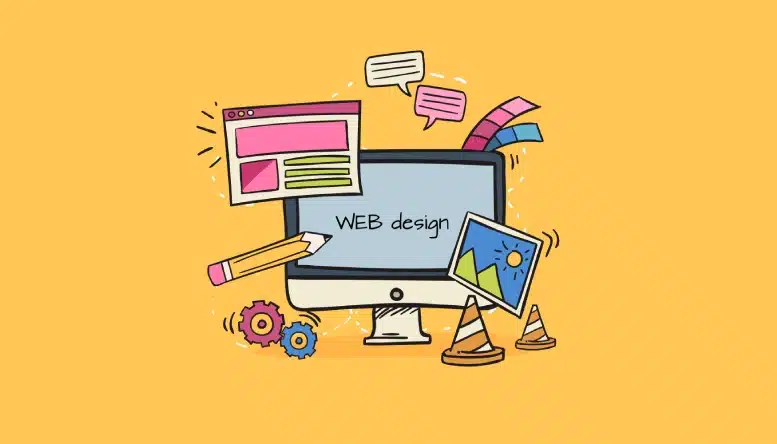Why consistency in branding is the secret weapon of a successful Website Design Agency
The Significance of User Experience in Efficient Web Design Approaches
User experience (UX) works as a cornerstone in reliable web design methods. It shapes how users interact with a site, influencing their contentment and likelihood of returning. A well-designed UX can improve interaction with intuitive navigation and responsive layouts. Overlooking these aspects might lead to aggravation and raised bounce rates. Comprehending the ins and outs of UX is vital for developers intending to produce engaging digital experiences that reverberate with diverse target markets. What factors absolutely drive effective user interaction?
Comprehending User Experience and Its Effect on Design
Although user experience (UX) is commonly perceived as a mere facet of web design, it basically shapes how users communicate with an internet site. UX incorporates all elements of the user's communication, including use, availability, and general contentment. A positive UX promotes involvement, encouraging customers to explore the site and return in the future. Alternatively, an unfavorable experience can bring about frustration, causing high bounce prices and lost opportunities for conversion.
Design elements like format, navigating, and web content organization play critical functions in shaping this experience. Effective UX design anticipates user needs and preferences, making certain that details is conveniently obtainable and visually enticing. In addition, recognizing user habits with analytics can offer beneficial insights, informing layout decisions that enhance usability. Ultimately, a detailed understanding of UX allows developers to develop websites that not just draw in customers yet additionally advertise significant interactions that align with organization goals and user assumptions.
Key Principles of Reliable User Experience
Effective user experience hinges on numerous key principles that boost website performance and interaction. Intuitive navigating style, responsive layout basics, and the significance of visual pecking order are crucial components that add to a seamless communication between users and web content. Understanding these principles allows developers to produce even more accessible and user-friendly electronic atmospheres.
Instinctive Navigating Design
When users run into a site, intuitive navigation style serves as an essential gateway to their overall experience. Reliable navigating enables individuals to easily find the details they seek, enhancing their communication with the site. Secret concepts consist of clear labeling, sensible organization, and regular placement of navigation aspects. Tags should be uncomplicated, allowing users to forecast the web content they will find. A well-structured power structure aids customers understand the partnership in between different sections, directing them via the web site perfectly. Furthermore, responsive menus and easily obtainable web links add to a fluid experience across tools. By prioritizing instinctive navigating, designers can significantly lower user aggravation and rise engagement, eventually fostering a positive understanding of the site and its content.
Responsive Design Fundamentals
A well-structured navigating system naturally causes the need for a receptive design, which is important in today's diverse electronic landscape. A receptive format assurances that websites function seamlessly throughout various devices, including desktops, smart devices, and tablets. This flexibility boosts user experience by enabling web content to be aesthetically systematic and easily obtainable, despite display size. Trick concepts of receptive design consist of fluid grids, adaptable pictures, and media queries, which assist in ideal watching. Additionally, focusing on touch-friendly components enhances communication on mobile devices. By implementing a receptive layout, developers can suit customers' demands, decrease bounce rates, and boost involvement. Ultimately, a well-executed receptive design promotes a favorable user experience, urging site visitors to check out the internet site better.
Visual Pecking Order Relevance
Visual pecking order plays a crucial role in guiding customers through an internet site, ensuring that vital info captures their interest. By strategically using size, shade, spacing, and contrast, developers can produce a clear pathway for individuals to adhere to. Larger elements often draw the eye, suggesting their relevance, while contrasting shades can highlight phone call to action. Furthermore, regular positioning and collection of associated content enhance understanding, making navigating intuitive. Reliable usage of aesthetic power structure not only boosts functionality but likewise sustains the overall visual of the site, cultivating a positive user experience. When customers can easily identify one of the most crucial info, they are most likely to engage with the web content, resulting in enhanced satisfaction and communication with the internet site.
The Role of Usability in Web Design
Usability plays an important role in web design, specifically via navigation simpleness and adherence to availability standards. Efficient navigation boosts user fulfillment by allowing visitors to discover info quickly and with ease. Meeting accessibility standards ensures that all users, no matter of their capacities, can properly connect with the website.
Navigating Simpleness
Simplicity in navigating stands as a cornerstone of efficient web design, greatly influencing user experience. A streamlined navigating system allows customers to find info quickly and without effort, minimizing irritation and enhancing complete satisfaction. Clear labeling and logical framework are crucial aspects, directing customers effortlessly through the web site. Redundant links or extremely complex food selections can disorient individuals, resulting in boosted bounce prices. Additionally, mobile responsiveness must be taken into consideration, ensuring navigating continues to be straightforward across tools. Prioritizing crucial web pages and lessening mess better sustains user click for more info involvement. Efficient navigation not only promotes a positive experience yet additionally motivates individuals to check out the site better, inevitably resulting in greater conversion prices. Hereof, navigating simplicity offers as a critical factor in the general efficiency of web design methods.
Access Specifications
User interaction is substantially enhanced when web sites abide by access criteria, guaranteeing that all users, no matter their capacities, can navigate and communicate properly. Conformity with these standards not only expands the target market however additionally enhances general user contentment. Accessible style integrates features such as text alternatives for photos, keyboard navigating, and enough shade comparison, which assist in use by people with impairments. In enhancement, executing these requirements can positively impact search engine optimization (SEO) by enhancing website framework and quality. As web design develops, focusing on access becomes vital in cultivating a comprehensive electronic setting. By accepting these standards, designers add to a much more fair internet, ultimately driving user commitment and engagement.
Significance of Responsive Style for User Engagement
As customers increasingly gain access to sites with a selection of tools, the significance of responsive layout ends up being read review extremely important for involving individuals successfully. Receptive style assurances that a web site adapts flawlessly to different display dimensions, providing an ideal watching experience despite the gadget utilized. This adaptability enhances user interaction by helping with simpler navigating and communication with content.
When customers encounter a site that is receptive, they are most likely to remain much longer, explore additionally, and return in the future. A well-designed receptive layout reduces the stress typically related to zooming and scrolling on smaller displays, consequently decreasing bounce prices. Furthermore, receptive style can favorably impact online search engine rankings, as internet search engine focus on mobile-friendly sites. In today's digital landscape, where mobile usage remains to climb, carrying out receptive layout is not simply useful, but necessary for maintaining user interaction and guaranteeing a positive experience throughout all tools.
Enhancing Load Times for Better User Contentment

To improve tons times, internet designers should prioritize optimizing images, leveraging internet browser caching, and minimizing HTTP requests. Furthermore, employing Material Distribution Networks (CDNs) can quicken material distribution by dispersing it throughout numerous geographic locations. Improving code, such as pressing CSS and JavaScript documents, additionally adds to faster filling speeds.
Ultimately, a dedication to boosting lots times not just enhances user contentment however likewise enhances brand name loyalty and enhances the probability of repeat brows through. A swift, smooth experience is crucial for keeping individuals and cultivating favorable interactions.
The Influence of Visual Power Structure on User Communication
Aesthetic hierarchy acts as a crucial aspect in guiding user interaction on a website. By organizing material in such a way that focuses on details aesthetically, developers can influence just how users engage and navigate with a site. This pecking order is established with different layout methods, including size, color, contrast, and spacing. As an example, bigger font styles or bold colors accentuate crucial elements, such as contact us to activity or headings, while controlled shades and smaller fonts can show secondary information.
Effective aesthetic hierarchy helps customers promptly recognize what is essential, lowering cognitive lots and enhancing use. It permits for user-friendly navigating, making it less complicated for customers to locate what they need without irritation. As customers communicate with an internet site, a well-structured visual hierarchy promotes a much more satisfying experience, ultimately bring about higher engagement and conversion prices. Developers need to focus on these principles to produce a reliable and user-centered web setting.
Gauging User Experience: Techniques and tools

Regularly Asked Concerns
Just How Can I Improve My Site's User Experience on a Budget plan?
To improve a website's user experience on a spending plan, one can optimize page load speed, simplify navigating, execute responsive layout, boost material quality, and gather user comments for continual refinements, making certain a rewarding visitor experience.
What Prevail User Experience Blunders to Stay Clear Of in Web Design?
Common user experience errors in web design consist of chaotic designs, poor navigating, sluggish loading times, lack of mobile responsiveness, overlooking ease of access, inconsistent branding, and stopping working to prioritize user comments - web design company. Each can considerably impede overall website performance
Just how Often Should I Update My Site for Better User Experience?
Internet sites should be updated frequently, ideally every couple of months, to preserve perfect user experience. Frequent updates aid address functionality problems, revitalize web content, and adapt to transforming user demands, making certain the website stays pertinent and interesting.

Can User Experience Effect SEO Rankings on My Site?
User experience can significantly affect search engine optimization positions, as search engines prioritize web sites that supply smooth navigating, fast filling times, and appealing web content. A positive user experience can result in reduced bounce rates and higher search exposure.
What Role Does Access Play in User Experience Design?
Availability plays a vital function in user experience layout by making certain that all individuals, no matter capabilities, can navigate and connect with an internet site successfully. This inclusivity boosts general fulfillment and interaction amongst diverse individuals.
User experience (UX) is typically viewed as a plain aspect of internet style, it essentially forms exactly how customers communicate with a website. User engagement is considerably enhanced when internet sites adhere to accessibility criteria, making certain that all customers, no matter of their abilities, can navigate and communicate properly. Determining user experience (UX) is important for recognizing how efficiently a web site fulfills the requirements of its customers. Additionally, use screening, where genuine users navigate the website while viewers note difficulties, offers straight comments on user experience. Typical user experience blunders in internet design consist of messy formats, bad navigating, sluggish filling times, absence of mobile responsiveness, ignoring access, inconsistent branding, and stopping working to focus on user responses.